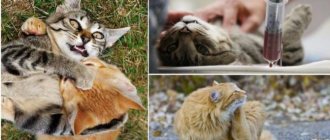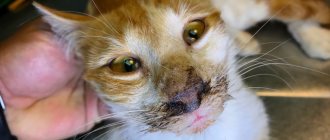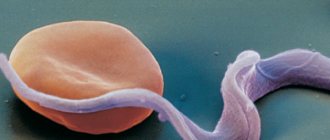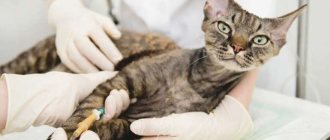Causes of paralysis in cats
Almost all diseases of cats can lead to a complicated course with the occurrence of paralysis. Even such a “harmless” disease as ear scabies can lead to paralysis - first, inflammation of the middle ear occurs, then the infection spreads to the inner ear and can then affect the membranes of the brain, it is because of the latter condition that there is a danger of paralysis.
Main factors:
- Spinal injury – falling from a height can damage the vertebrae and spinal cord. Depending on the affected area, paralysis can occur in both the hind and forelimbs; most often the lesions are symmetrical. Symptoms come on suddenly and may worsen rapidly over a short period of time
- Inflammatory processes of the spinal cord - usually due to infectious processes, parasitic lesions, complicated trauma and poisoning.
- Fibrous-cartilaginous embolism is a violation of blood circulation in an organ due to blockage of a vessel with a blood, fat or tumor piece. Severe tissue ischemia and subsequent necrosis occurs.
- Stroke is damage to the blood vessels of the brain; with this pathology, its normal functioning is disrupted and motor function is impaired, up to complete paralysis.
- Ixodid tick infestation causes paralysis due to the toxins released by the tick during the bite. Occurs 6 days after the bite.
- Gas poisoning.
- A dangerous viral infection - in most cases, rabies infection leads to paralysis, the larynx is especially often affected, and breathing stops.
Routes of infection
Cats become infected with coronavirus infection from a sick animal. Since the virus lives in the intestines, the main route of infection is fecal-oral. The infection enters the body by sniffing feces, licking fur, or examining marks. A less common route of spread is airborne droplets. An animal can become infected with the virus in a nursery, in a foster home, or in a veterinary clinic, if contact between cats and each other is not excluded.
Kittens become infected from their mother. This occurs in utero or after birth during care of the offspring. As a rule, the entire litter of a sick cat is affected. A cat, if it does not live in the same apartment (as happens with breeders), does not transmit the virus to its offspring.
FIP in cats can be asymptomatic or mild, but the animal remains a source of infection for life.
If there is only one cat in the house, there is nothing to be afraid of; if there are several, then everyone will be infected. A sick animal should be excluded from breeding and should not be allowed to come into contact with the kittens of other females.
Types of paralysis in cats
There are several types of paralysis that characterize the degree of the disease. These include symmetrical lesions - paraplegia , in which both lower limbs are involved in the process at once. With hemiplegia , the thoracic and pelvic region is damaged, and paralysis affects the paws on one side of the body.
Tetraplegia is complete paralysis of all four limbs.
In monoplegia , only one limb is affected.
The disease is also divided according to the area affected:
- Facial nerve paralysis.
- Hind limbs.
- Spinal paralysis.
- Laryngeal paralysis.
- Damage to the radial nerve - this disease refers to obstetric injuries that occurred during childbirth.
What it is
Very often this pathology is confused with paralysis. It is not right. You can also hear that the difference between paresis and paralysis is that in the first case the cat can (albeit poorly) move, but in the second it cannot. This is also incorrect. Even with paresis (with the exception of mild cases), a sick cat will clearly not flutter around the house like a butterfly.
The point is partial preservation of skin sensitivity and motor function. So, if we compare postpartum paresis in cats and paralysis, then in the first case the animal is still unwell, but feels pinches and pin pricks, but in a paralyzed pet the affected part of the body turns into a “tree”, devoid of sensitivity.
However, sometimes the difference between paralysis and the pathology we describe is very “ephemeral”. This happens when the “borderline” condition is caused by severe back injuries. The fact is that when the spine is damaged, bone fragments can only slightly “scratch” the surface of the spinal cord. As soon as they press a little harder, the paresis “naturally” turns into paralysis.
In addition, even the postpartum type of pathology can result in a complete loss of sensitivity and mobility if the animal does not receive proper treatment. So you need to take this disease extremely seriously. The slightest delay or inaccuracy - and your pet will forever remain in a “numb” state.
Thus, paresis of the limbs in cats (as a rule) develops against the background of severe injuries. This happens especially often in the spring, when animals begin to actively look for a mate for procreation. Cats fall from balconies, get run over by cars, and are injured in other ways. But severe injuries and mechanical effects on the spine are not to blame for all cases of paresis. Sometimes the cause is a severe metabolic disorder.
Symptoms of paralysis in cats
Almost all symptoms of paralysis depend on the affected area and the causes of its occurrence. However, there are several common signs:
- “Drunk”, uncertain gait.
- Significant reduction in movement in the paws or complete paralysis.
- Severe pain - the cat may cry when touched, avoid communication, and become aggressive.
Spinal injury - weakness or loss of movement of the hind limbs, incontinence of feces and urine, the tail may also be immobile. The cat does not react in any way to touching its hind legs due to the loss of pain and tactile sensitivity.
With thrombosis , there will be a difference in the temperature of the limbs (the affected one will be cold), the absence of pulsation of the arteries in the paw, and a blue tint to the skin.
Spinal hernias are accompanied by stiffness when walking, the animal mainly lies down. He moves reluctantly, his back is hunched. When stroked, it meows. Aggressive - due to pain in the back and affected limbs.
Tick paralysis - for several days the cat is lethargic and constantly sleeps. The pupils are dilated, difficulty swallowing appears, and as a result, refusal to eat.
With laryngeal paralysis, loss or change in voice is often observed, and swallowing is complicated. Breathing becomes noisy and hoarse.
Facial paralysis can be either symmetrical or unilateral. There is increased salivation. The muzzle loses symmetry - one corner of the mouth and eye “creeps” downward, and there is no blinking or movement of facial muscles on the affected part. With bilateral lesions, the expression of the muzzle becomes dull due to the lowering of the corners of the mouth.
Radial nerve palsy - decreased activity, the forelimb is extended forward when walking and resting.
Diagnosis of paralysis in cats
Laboratory diagnostics help identify the cause of the disease.
General blood, urine and biochemistry tests monitor the animal’s condition.
For a detailed check, an MRI of the brain and spine is often required.
If infection is suspected, bacteriological analysis is recommended.
To exclude neoplasms and injuries, ultrasound and radiography are usually used. It is worth conducting Doppler sonography to check the filling of blood vessels and access of blood to the extremities.
The limbs are tested for tendon reflexes, tactile and pain sensitivity. This is done in order to assess the extent of the damage.
Treatment of paralysis in cats
Paralysis is a serious symptom and requires immediate medical attention. Therapy will depend on the cause of the disease. It is worth preparing for the fact that the treatment will be lengthy and rarely leads to complete restoration of movements.
It is necessary to take comprehensive measures, which include nutrition, medication and physiotherapy.
In case of paralysis, it is worth giving easily digestible foods, preferably in the form of purees. Nutrition should be complete and include all the necessary vitamins.
For injuries and inflammations, I usually use anti-inflammatory steroids - metipred, preferably administered by drip three times a day.
Injections of B vitamins are used as strengthening therapy; they help speed up the recovery of damaged peripheral nerves.
Pain is relieved with non-steroidal anti-inflammatory drugs -
- Rimadyl,
- carprodil,
- Flexoprofen.
For significant pain, opioid substances are used -
- hydromorphone,
- fentanyl,
- buprenorphine.
If thromboembolism is detected, then anticoagulants are used -
- heparin,
- aspirin,
- clopidogrel.
For injuries and hernias, surgical treatment is recommended. During the operation, bone fragments are compared and the pelvis and spine are restored, and the hernia is truncated.
Tick paralysis has an etiotropic treatment - a special anti-tick serum.
Also, in order to relieve dehydration, dehydration is carried out using droppers with saline solutions.
In cases of respiratory failure, oxygen therapy or mechanical ventilation is performed.
Physiotherapy
Myoelectric stimulation and massages are often used to restore sensitivity. The latter procedure can be carried out at home with prior consultation with a doctor, since in some cases it may be contraindicated.
Perform passive movements with your paws, bending and extending the limb. Stroke and knead them, stimulate walking with the support of the animal, correctly placing the paws when walking.
Scabies manifestations
Experts note that you can also catch a disease such as scabies from cats. The infection is caused by the mite Sarcoptes scabei. This mite is considered an external parasite of the skin of pets. When the pathogen is transferred to human skin, symptoms such as itching and rash in the form of papules begin to appear. Secondary pustules may appear due to scratching and complications against this background.
Again, banal hygiene decides everything - you need to wash your hands more often after contact with your pet, do not kiss him, give him preventive examinations at the veterinarian on time and give him the necessary vaccinations. Naturally, it is necessary to carry out antiparasitic treatment in a timely manner, which will reduce the risks. And, of course, you should change your pet’s litter box with gloves and thoroughly wash your hands with soap after the procedure.
Prevention
- Do not start infectious and parasitic diseases by carrying out the full course of necessary therapy.
- Do not overfeed your pet, be sure to take measures to prevent obesity.
- It is advisable to limit the cat's free movement along the street. Castrate or neuter.
- The sleeping area should be warm and located in a draft-free room.
- When walking, wear special anti-parasitic collars or drop drops on the withers.
Description of the disease
Fip or ICP (viral peritonitis) is a serious disease that affects the mucous membranes of the abdominal cavity of an animal. Infectious peritonitis has become most active in the last 10–20 years. The disease was first recorded in 1960 in America, but many believe that the virus developed even earlier. The disease is considered fatal, although death occurs in most cases when a large number of pets gather in one area.
© shutterstock
There are many types of coronaviruses that characterize Fip. Some of them are only slightly dangerous and can cause short-term diarrhea in cats. Others imply a rather serious pathology that ends in the death of the pet. Unfortunately, it is currently impossible to accurately determine what type of infection a cat is infected with. Based on the symptoms, the veterinarian can only determine the presence of coronavirus. Fatal infectious peritonitis is diagnosed too late, when the animal has minimal chance of survival.
In addition, recent studies have shown that coronaviruses are capable of rapid mutation. Because the virus tends to persist indoors for weeks to months, there is no optimal protection for felines living in large groups in confined spaces.
Viral peritonitis is the most common form of coronavirus. Fip can be transmitted through the oral-fecal route. Infection can occur through food or cat feces. For several months it is excreted from the pet’s body, then it subsides for a while. This occurs due to the production of antibodies by the body of a sick pet. A healthy cat can become infected through feces if they are exposed to the public. Sometimes an animal is a carrier of the disease in the absence of characteristic symptoms.
Since viral bacteria can easily be destroyed under the influence of conventional disinfectants and detergents, it is extremely important to maintain cleanliness in the room where cats live.
© shutterstock











